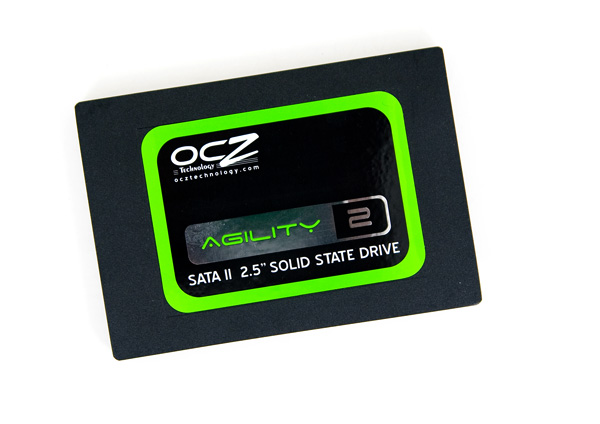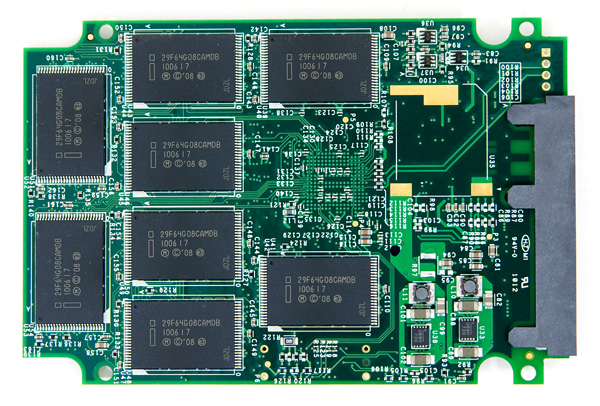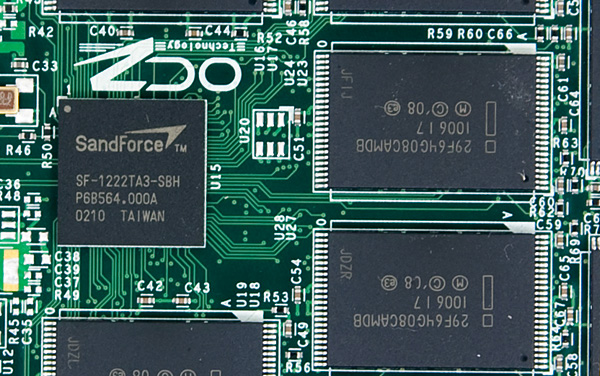OCZ's Agility 2 Reviewed: The First SF-1200 with MP Firmware
by Anand Lal Shimpi on April 21, 2010 7:22 PM ESTOCZ's Agility 2 and the SF-1200
Relegating Indilinx to the bottom of the pyramid for now is a bold move for OCZ. Considering how much business OCZ has given Indilinx over the past year I don’t expect that they are very happy over this move.
SandForce’s architecture is on a different level from what we’ve seen from Indilinx. While the Vertex could be viewed as an Intel alternative, OCZ’s Vertex 2 and Agility 2 are designed to offer better-than-Intel performance and as such they actually command a higher dollar-per-GB rate.

Both the Vertex 2 and Agility 2 are based on SandForce’s SF-1200 controller. I’ve described the differences between this and the SF-1500 in detail here. It boils down to a bunch of enterprise class features missing and lower sustained small file random write speed on the SF-1200 vs. the 1500.
The Vertex 2 retains the small file random write performance of the SF-1500, while the Agility 2 is a standard SF-1200 implementation. According to SandForce, the Agility 2 is representative of how all other SF-1200 based SSDs will perform using the 1200’s current mass production firmware (more on this later).


Note the missing super cap, that's a feature of enterprise SF-1500 designs
OCZ sent in their Agility 2 for review, arguably the more interesting of the two since we already have an idea of how the Vertex 2 will perform. Similar to previous Agility drives, the new A2 shaves a small amount off the retail price of the Vertex 2 in exchange for lower performance:
| OCZ SandForce Drive Pricing (MSRP) | |||||
| 50GB | 100GB | 200GB | |||
| OCZ Agility 2 | $204.99 | $379.99 | $719.99 | ||
| OCZ Vertex 2 | $219.99 | $399.99 | $769.99 | ||
The Agility 2 ships with a 2.5" to 3.5" drive sled for use in desktops. If you use this sled the SATA ports won't line up with drive trays in systems like the Mac Pro.
Inside the drive itself we find SandForce’s SF-1200 controller and no external DRAM. SandForce’s architecture attempts to solve the issue of NAND write amplification by simply writing less to the drive through compression/deduplication techniques. With less data to keep track of, a large external DRAM isn’t necessary - assuming the data being written is easily reduced by SandForce’s algorithms.
SandForce also claims that its reduced write amplification could enable the use of cheaper NAND on these drives. It’s an option that some manufacturers may take however OCZ has committed to using the same quality of NAND as it has in the past. The Agility 2 uses 34nm IMFT NAND, presumably similar to what’s used in Intel’s X25-M G2.

The Agility 2 sample OCZ sent had the first SF-1200 mass production firmware (v3.0.5) from SandForce on it with full TRIM support. The Agility 2 should begin shipping to etailers later this month.










60 Comments
View All Comments
speden - Wednesday, April 21, 2010 - link
I still don't understand if the SandForce compression increases the available storage space. Is that discussed in the article somewhere? Is the user storage capacity 93.1 GB if you write uncompressable data, but much larger if you are writing normal data? If so that would effectively lower the cost per gigabyte quite a bit.Ryan Smith - Wednesday, April 21, 2010 - link
It does not increase the storage capacity of the drive. The OS still sees xxGB worth of data as being on the drive even if it's been compressed by the controller, which means something takes up the same amount of reported space regardless of compressibility.The intention of SandForce's compression abilities was not to get more data on to the drive, it was to improve performance by reading/writing less data, and to reduce wear & tear on the NAND as a result of the former.
If you want to squeeze more storage space out of your SSD, you would need to use transparent file system compression. This means the OS compresses things ahead of time and does smaller writes, but the cost is that the SF controller won't be able to compress much if anything, negating the benefits of having the controller do compression if this results in you putting more data on the drive.
arehaas - Thursday, April 22, 2010 - link
The Sandforce drives report the same space available to the user, even if there is less data written to the drive. Does it mean that Sandforce drives should last longer because there are fewer actual writes to the NAND? One would reach the 10 million (or whatever) writes with Sandforce later than with other drives.Ryan Smith - Thursday, April 22, 2010 - link
Exactly.MadMan007 - Wednesday, April 21, 2010 - link
On a note somewhat related to another post here, I have a request. Could you guys please post final 'available to OS' capacity in *gibibytes*? (or if you must post gigabytes to go along with the marketers at the drive companies make it clear you are using GIGA and not GIBI) After I realized how much 'real available to OS' capacity can vary among drives which supposedly have the same capacity this would be very useful information...people need to know how much actual data they can fit on the drives and 'gibibytes available to the OS' is the best standard way to do that.vol7ron - Wednesday, April 21, 2010 - link
Attach all corrections to this post.1st Paragraph: incredible -> incredibly
pattycake0147 - Thursday, April 22, 2010 - link
On the second page, there is no link where the difference between the 1500 and the 1200 are referenced.Roland00 - Thursday, April 22, 2010 - link
The problem with logarithmic scales is your brain interprets the data linerally instead of exponentially unless you force yourself not too.Per Hansson - Thursday, April 22, 2010 - link
I agreeJust as an idea you could have the option to click the graph and get a bigger version, I guess it would be something like 600x3000 in size but would give another angle at the data
Because for 90% of your users I think a logramithic scale is very hard to comprehend :)
Impulses - Thursday, April 22, 2010 - link
Not sure if this is the best place to post this but as I just remembered to do so, here goes... I have no issues whatsoever with your site re-design on my desktop, it's clean, it's pretty, looks fine to me.HOWEVER, it's pretty irritating on my netbook and on my phone... On the netbook the top edge of the page simply takes up too much space and leads to more scrolling than necessary on every single page. I'm talking about the banner ad, followed by the HUGE Anandtech logo (it's bigger than before isn't it), flanked by site navigation links, and followed by several more large bars for all the product categories. Even the font's big on those things... I don't get it, seems to take more space than necessary.
Those tabs or w/e on the previous design weren't as clean looking, but they were certainly more compact. At 1024x600 I can barely see the title of the article I'm on when I'm scrolled all the way up (or not at all if I've enlarged text size a notch or two). It's not really that big a deal, but it just seems like there's a ton of wasted space around the site navigation links and the logo. /shrug
Now on to the second issue, on my phone while using Opera Mini I'm experiencing some EXTREME slowdowns when navigating your page... This is a much bigger deal, it's basically useless... Can't even scroll properly. I've no idea what's wrong, since Opera Mini doesn't even load ads or anything like that, but it wasn't happening a week or two ago either so it's not because of the site re-design itself...
It's something that has NEVER happened to me on any other site tho, they may load slow initially, but after it's open I've never had a site scrolls slowly or behave sluggishly within Opera Mini like Anandtech is doing right now... Could it be a rogue ad or something?
I load the full-version of all pages on Opera Mini all the time w/o issue, but is there a mobile version of Anandtech that might be better suited for my phone/browser combination in the meantime?